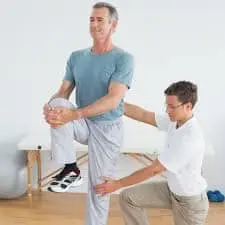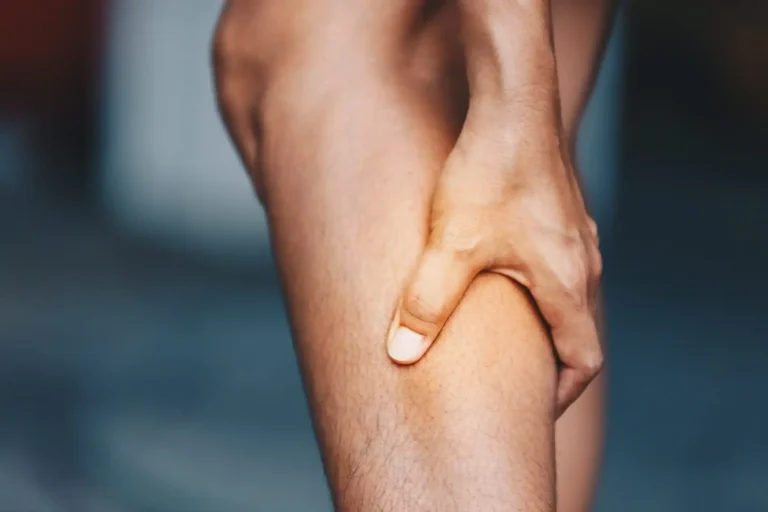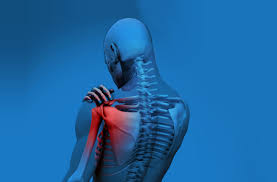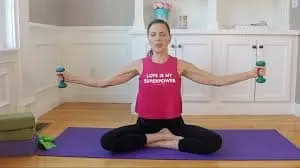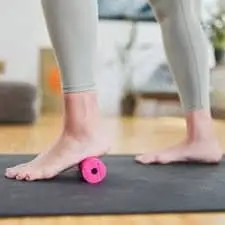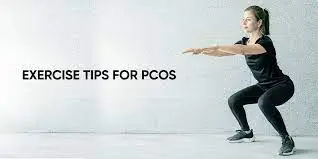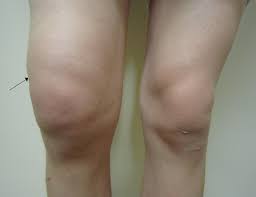32 Best Exercises for Hip Osteoarthritis
Exercises for Hip osteoarthritis play a crucial role in managing hip pain by improving joint flexibility, strength, and function, as well as reducing pain and inflammation.
Hip osteoarthritis is a common condition characterized by the degeneration of cartilage in the hip joint, leading to pain, stiffness, and reduced mobility.
What is Hip Osteoarthritis?
Degenerative diseases like osteoarthritis come from the degeneration of cartilage. As a result, pressure is put on the bones, which can lead to bone spurs, pain, and stiffness. The most typical sign of osteoarthritis of the hip is pain near the hip joint, This usually feels in the area of the groin. The pain usually starts slowly and gets worse over time.
Being unable to exercise may be due to pain if you have hip osteoarthritis. Muscular atrophy and osteoarthritis may be worsened by inactivity. Frequent exercise is helpful to strengthen muscles, improve balance, and stabilize your hip joints.
Introduction:
It is important for recovering movement and strength following hip osteoarthritis. exercises will help with tissue repair and allow you to resume your activities. If you’re new to exercising, it’s a good idea to start lightly and increase over time.
With hip osteoarthritis, exercise is an important part of your therapy program.
Osteoarthritis management is greatly affected by physical exercise. Pain, stiff joints, and muscle tiredness can all be reduced with exercise.
In addition to exercising frequently, you may improve your movement while you’re doing your daily activities. Including slight exercise in your routine can improve the way you feel and stay healthy.
Your age and general health status are two important factors that can help you decide which exercises are ideal for you. Consult your doctor before starting a new fitness schedule, or ask them to suggest a physical therapist.
Resuming your usual routine of exercise may require some time, and the first effects may not be visible right away. But the greatest strategy to get beneficial long- and short-term results following hip osteoarthritis is to gradually resume normal activity.
Signs and symptoms:
- Pain is primarily felt deep in the front of the thigh or groin area, but it can also spread to the buttocks or knee.
- There can be a crackling sound when you move your hip joint, and there might be restrictions on its range of motion.
- Stiffness increases after a period of inactivity in your joints.
- You could discover that certain everyday tasks are more difficult if you have severe osteoarthritis. challenging, such as climbing stairs, putting on shoes or socks, crossing your legs, bending over, and walking.
- More severe Osteoarthritis might also cause difficulty sleeping.
Benefits of Exercise for Hip Osteoarthritis:
The following are some advantages of exercise;
- Long-term pain reduction can be achieved with exercise.
- You might be able to regain hip mobility with exercise.
- Your muscles can become stronger with regular exercise.
- Your hip joint might become more stable with exercise.
- Regular physical activity could help with posture correction or balance improvement.
- You may improve your range of motion for everyday activities by performing regular exercise.
- Building strength can be achieved through exercise.
How hip osteoarthritis can be managed with exercise:
Exercise is helpful for hip arthritis for a few reasons. In addition to improving general health, it can increase joint flexibility and mobility and develop powerful muscles that will support and relieve pressure from your hip joint. When combined, these could reduce your hip pain.
Exercise has positive effects on a person’s physical, emotional, and psychological health. Managing chronic pain can be mentally exhausting. Exercise releases endorphins, which are hormone-like hormones that improve mood and reduce pain. Exercise may also help you in maintaining or lowering your weight, which may reduce the effects of hip osteoarthritis.
What is the recommended amount of exercise?
Do the exercises once or twice a day, paying attention to the tips below.
- The workouts are often arranged according to difficulty.
- Continue the exercise until you believe you have reached this ideal level of intensity.
- If you feel like you are working harder than this, the exercise can be too challenging, in which case you should go back to the easier one.
- If you are unable to accomplish this, the exercise may be too easy for you, in which case you should proceed to the next one.
- You can use a pillow when performing the lying exercises on a bed or the floor.
- Should you require support, the standing exercises should be performed with it available.
The Most Effective Hip Osteoarthritis Exercise:
The most effective exercises to help you move your hips more freely and reduce hip osteoarthritis pain are listed below.
Bridging
- Placing your feet level on the floor and bending both of your legs at the knees, lie flat on your back.
- With your hands facing down, keep your arms by your sides.
- If head and neck support is needed, place a small pillow below.
- Lift your back after gradually raising your pelvis.
- Make sure that your shoulders and upper body stay on the ground.
- Gradually move down the pelvis and back toward the ground, starting at the top of the spine.
- Once again, lower yourself into the spine until your entire back is flat on the floor.
- Hold the position for a short while.
- Then return to your neutral position.
- Then relax.
- Perform this exercise five to eight times.
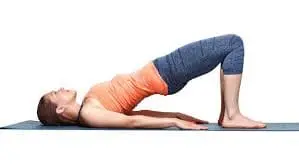
Chair stand
- Select a solid chair without armrests and take a seat near the front of it.
- Bend your knees and place your feet shoulder-width apart on the floor below your hips.
- As you raise your chest slightly forward, keep your neck and back straight.
- Breathe in slowly.
- Bend slightly forward to shift your weight to the front of your feet.
- Breathe out as you gently stand up.
- Avoid from holding any weight with your hands.
- Maintaining your peace, take deep breaths in and out.
- Breathe in as you sit down slowly.
- Tighten your core and abdominal muscles to help you control your lowering as much as possible.
- Return to your beginning position and sit down slowly.
- Then return to your neutral position.
- Then relax.
- Perform this exercise five to eight times.
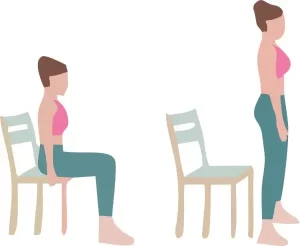
Hip flexor stretch
- Kneel on both knees on an exercise or yoga mat.
- Your feet should be set on the mat with your bottom on the heel of your feet.
- Press your palms to the mat while bending forward.
- To keep your elbows from locking, bend them slightly and keep your hands shoulder-width apart.
- With your left knee pulled forward into the space between your arms, make a 90-degree angle, and place your left foot flat on the mat in front of you.
- For balance and support, straighten your upper body and rest both hands on your left knee in front of you.
- Bring your right leg forward in front of you.
- With the top of your right foot resting on the mat, your right knee should be forced into the surface.
- For a deeper stretch, bend forward a little bit.
- Hold the position for a short while.
- Then return to your neutral position.
- Then relax.
- Perform this exercise five to eight times.
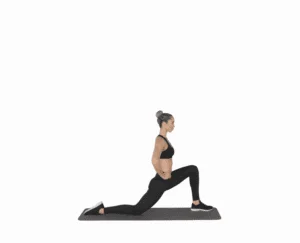
Seated Hamstring Stretch
- Remember to sit with good posture when seated on a table, yoga mat, or bed.
- Keeping your toes free and pointed upward, lay your heel on the floor and extend the leg you want to stretch straight.
- Shift your weight and maintain a flat back while bending forward at the hips.
- Maintain the forward bending of your trunk until your lower leg begins to stretch out.
- Hold the position for a short while.
- Then return to your neutral position.
- Then relax.
- Perform this exercise five to eight times.
- Perform exercise on the other side.
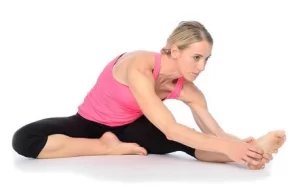
Double hip rotation
- Lie completely flat on your back.
- After that, raise your knees toward your body while bending them until your feet are flat on the floor.
- Bend the knees slightly to the left, lowering them to the ground.
- Head to the right while keeping your shoulders up against the floor.
- Hold this position for a few seconds.
- Slowly return your head and knees to their starting positions.
- Then return to your neutral position.
- Then relax.
- Perform this exercise five to eight times.
- Perform exercise on the other side.
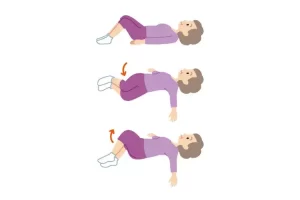
Hip and lower back stretch
- Lying flat on your back, bend your knees toward your body until your feet are flat on the floor.
- Using your hands, pull each knee in toward the chest.
- Bring your knees up to your shoulders with each inhalation.
- Stretch as far as it is comfortable for you to go, then keep there for a short while.
- Then return to your neutral position.
- Then relax.
- Perform this exercise five to eight times.
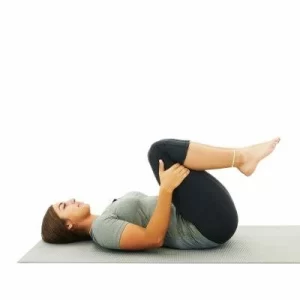
Hip extension
- Spread your feet shoulder-width apart and remain erect.
- Extend your arms out in front of you and hold onto a wall, chair, or table for support.
- Raise the left leg backward without bending the knee, keeping the right leg straight.
- Squeeze the buttock lightly after raising the leg as high as you can without hurting it.
- Hold this posture for a short while.
- Then return to your neutral position.
- Then relax.
- Perform this exercise five to eight times.
- Perform exercise on the other side.
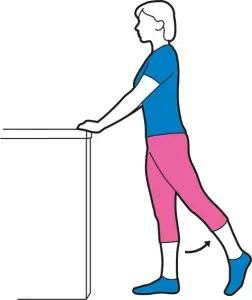
Prone leg straight raise exercise
- Go on the floor and lie face down, prone.
- Tighten your core muscles progressively as your abdominal muscles are tensed.
- Breathing should be possible while performing this.
- Gently raise one leg backward while maintaining your knees straight and your abs tight.
- As your leg rises off the ground, maintain a straight knee.
- After a few seconds of holding your leg straight up in the air, carefully get it back to the ground.
- When elevating your leg, take care not to rotate your pelvis or back.
- Then return to your neutral position.
- Then relax.
- Perform this exercise five to eight times.
- For the other leg, repeat the exercise.
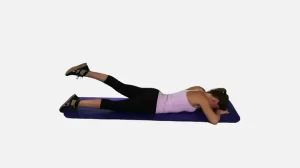
External hip rotation (lying)
- Lay flat on the bed with your feet hip-width apart and your knees bent.
- Lower one knee to the bed, then raise it back up.
- Hold this position for a few seconds.
- At all times keep your back flat on the bed.
- Then return to your neutral position.
- Then relax.
- Perform this exercise five to eight times.
- Repeat the exercise with the other leg.
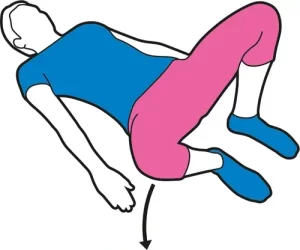
Heel Slide
- Lying on your back, spread your legs wide apart and your feet slightly apart.
- As near your buttocks as possible, try sliding the affected leg.
- Move your heel back to its initial position.
- Hold this posture for a short while.
- Then return to your neutral position.
- Then relax.
- Perform this exercise five to eight times.
- With the other leg, perform the exercise again.
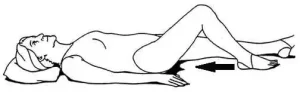
Single Knee-to-Chest Exercise
- With your knees bent and your feet flat on the ground, begin by lying down on your back.
- Then, raise one knee to your chest by putting your hands around it.
- Hold this posture for a short while.
- Now release and return your knee to its beginning position.
- Then return to your neutral position.
- Then relax.
- Perform this exercise five to eight times.
- Repeat the exercise with the other leg.
- Try keeping your opposite leg flat on the floor while you raise your knee if you want to get more stretch out of the exercise or if it feels better on your back.
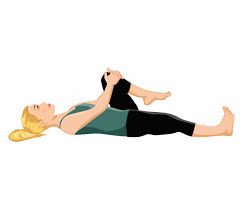
Reclined Butterfly Pose
- Sit with your back straight, legs extended, feet in contact, and toes pointed skyward.
- Now, lift your feet to your pelvis while bending your knees.
- Your feet should be in contact with one another, forming a circular shape with your legs.
- Inhale slowly, and try your best to get it straight to your spine and chest.
- You can gently lie down and place your back on the floor after you’re comfortable.
- In this position, let your muscles relax and take five to ten deep breaths.
- Then return to your neutral position.
- Then relax.
- Perform this exercise five to eight times.
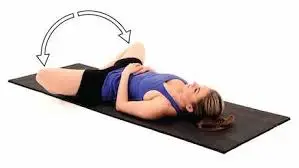
Clam Hip Abduction
- Place your knees and feet together and gently lie on your side to start.
- As you flex your hips 20 to 30 degrees, your pelvis will go forward.
- Now raise your top knee to expand your legs.
- Hold it for a few seconds.
- After finishing, slowly lower your leg back.
- Then return to your neutral position.
- Next, relax.
- Perform this exercise five to eight times.
- Repeat the exercise with the other leg.
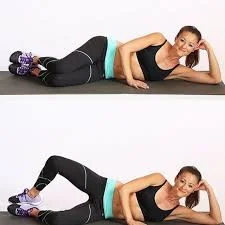
Side-lying leg raise
- On the floor or a yoga mat, lie on your right side to sleep.
- Maintain an upright posture by keeping your legs extended and your feet placed on top of each other.
- You can support yourself by resting your arm straight on the floor under your head or by grabbing it with your elbow bent.
- Stretch your left hand out in front of you or let it rest on your hip or leg for additional support.
- Release the breath and lift your left leg off the floor.
- As soon as you feel your muscles contract, stop lifting your leg.
- Hold this position for a few seconds.
- Breathe out and then lower the leg till it touches the right leg again.
- Then return to your neutral position.
- Next, relax.
- Perform this exercise five to eight times.
- Repeat the exercise with the other leg.
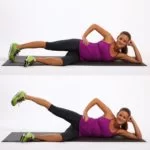
Standing hamstring curl
- Make sure your feet are hip-width apart as you stand.
- To balance, put your hands on the hips or a chair.
- You should now be entirely supported by your left leg.
- As you slowly bend your right knee, the heel should be moving toward your butt.
- Keep your thighs in a neutral position.
- Hold this position for a few seconds.
- Put your foot down slowly.
- Then return to your neutral position.
- Next, relax.
- Perform this exercise five to eight times.
- Repeat the exercise with the other leg.
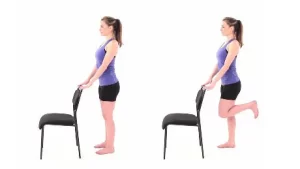
Hamstring Band Stretch
- Place yourself comfortably on a yoga mat on your back.
- With a slightly bent knee, raise one leg off the mat.
- Apply a resistance band to the sole of the outstretched leg.
- Raise the leg in as close to your chest as is comfortable.
- Hold it for a few seconds.
- Then return to your neutral position.
- Next, relax.
- Perform this exercise five to eight times.
- Repeat the exercise with the other leg.
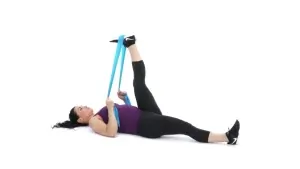
Pelvic tilt
- With your knees bent, your feet straight to the floor, and your arms by your sides, take a lying position.
- Tighten your lower abdominal muscles and press your abdomen toward your spine without using your leg or buttock muscles to help you.
- Your pelvis moves slightly as your lower back presses on the floor during this exercise.
- Hold it for a few seconds.
- Then return to your neutral position.
- Next, relax.
- Perform this exercise five to eight times.
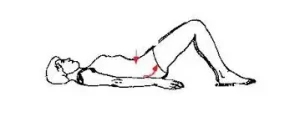
Marching on the ball
- Position your feet in front of you as you sit on the exercise ball.
- Your feet should be level with the ground and spaced about shoulder-width apart.
- Keeping your toes on the ground, raise one heel.
- Raise your foot completely off the ground for an even bigger challenge.
- Hold it for a few seconds.
- Then return to your neutral position.
- Next, relax.
- Perform this exercise five to eight times.
- On the other leg, perform the exercise again.
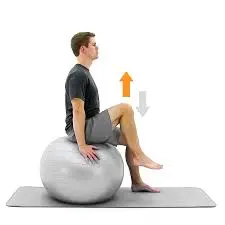
Seated Leg extensions
- First, take a long chair and sit up straight, putting your leg resting or down.
- Look straight ahead, contract your thigh muscles, and raise one leg as high as you can to build strength without raising your bottom off the chair.
- Hold it for a few seconds.
- Then return to your neutral position.
- Next, relax.
- Perform this exercise five to eight times.
- On the other leg, perform the same exercise again.
Side-lying hip abduction
- Raise your injured upper leg and bend your lower leg to help with self-support as you lie on your side.
- keeping your knee straight but not locked.
- Maintain an upright position and gradually elevate your upper leg to a 45° angle.
- Hold it for a few seconds.
- Then return to your neutral position.
- Next, relax.
- Perform this exercise five to eight times.
- Perform the exercise on the other side.
Leg slides (abduction/adduction)
- Start by lying on the floor in an upright position.
- Stretch your leg out to the side while keeping your kneecap up.
- Hold this posture for a few seconds.
- To return to the initial position, slide your leg back.
- Then return to your neutral position.
- Next, relax.
- Perform this exercise five to eight times.
- On the other leg, perform the same exercise again.
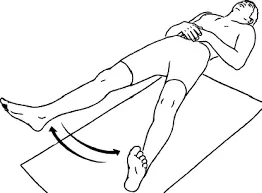
Straight Leg Raise
- Start by resting down on the floor or a table in a comfortable position.
- Now slightly bend your knee.
- Then raise your leg gradually.
- While maintaining a straight knee on the opposite side.
- After that, hold for a few seconds.
- Next, lower your leg.
- Then return to your neutral position.
- Next, relax.
- Perform this exercise five to eight times.
- Work out the same way on the opposite leg.
Walking
- One of the best exercises for hip arthritis is walking.
- Walking increases blood flow to the cartilage in your body, providing it with the nutrients it needs to protect the ends of your joints.
- To build up your strength, start with 20 to 30 minutes at a session, three to five times a week, and then progressively increase the time and frequency.
Standing hip abduction
- When standing, place your feet hip-width apart and hold onto a chair or countertop for stability.
- Raise a single leg to the side.
- As you raise your leg, take care not to rotate your pelvis.
- Your hips should be pointed forward.
- Make sure that your hip remains in the same position during the workout.
- Hold this position for a few seconds.
- Return your leg slowly.
- Then return to your neutral position.
- Next, relax.
- Perform this exercise five to eight times.
- On the other leg, repeat the same movement once again.
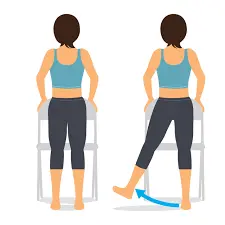
Standing hip flexion
- Place your legs shoulder-width apart as you stand.
- For support, hold on to a sturdy chair or table.
- Kick your leg forward carefully and slowly while maintaining a straight knee and pointed toes.
- Hold this position for a few seconds.
- Then return to your neutral position.
- Next, relax.
- Perform this exercise five to eight times.
- On the other leg, repeat the same movement once again.
Mini-Squats
- For balance, lay your hands on the back of a chair, table, or countertop while standing with your feet shoulder-width apart.
- Bend your knees as though you were ready to take a seat.
- Contract your thigh muscles and stop one-third of the way down to bring your body back up to a standing position.
- Focus on maintaining proper posture by standing up straight from your heels.
- Your knees must bend straight forward toward your toes rather than making contact with one another.
- Then return to your neutral position.
- Next, relax.
- Perform this exercise five to eight times.
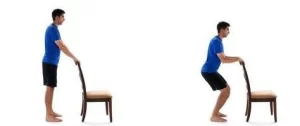
Short arc quad exercises
These exercises strengthen VMO Muscle.
- To begin, lie on your back on a bed or the ground.
- Under your knees, place your huge rolled-up towel or foam roll.
- Place your heels on the floor or bed for the start.
- Raise the bottom of one leg till it is straight.
- Maintain your knee’s back resting on the towel or foam roll.
- Hold this position for a few seconds.
- After that, gently bend your knee and return your heel to the floor or bed.
- Then return to your neutral position.
- Next, relax.
- Perform this exercise five to eight times.
- On the other leg, complete the same exercise again.
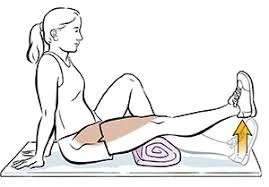
Seated Rotation Stretch
- Take a seat on the ground and extend both of your legs in front of you.
- Put one leg across the other.
- With your hand supporting you from behind, slowly turn toward your bent leg.
- Use the opposing arm to support your bent thigh as you continue to twist.
- Hold this position for a few seconds.
- Then return to your neutral position.
- Next, relax.
- Perform this exercise five to eight times.
- Switch up your leg positions and do the stretch again on the other side.
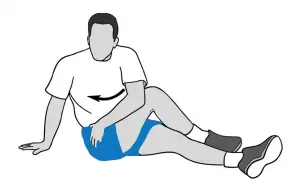
Hip Adduction
- Extend both legs straight out as you lie on the side of your affected leg.
- Cross your upper leg over your affected leg and bend it.
- Lift your affected leg about six to eight inches off the ground.
- Hold this position for a few seconds.
- Lower your leg slowly.
- Then return to your neutral position.
- Next, relax.
- Perform this exercise five to eight times.
- Change your leg and repeat the exercise on the opposite side.
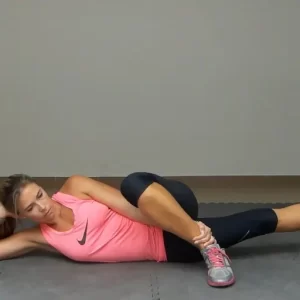
Hip Extension (Prone)
- Lay flat on your stomach on something solid with a pillow under your hips.
- One knee should be bent 90 degrees.
- Raise your leg straight up.
- Hold this position for a few seconds.
- Lower your leg slowly to the ground.
- Then return to your neutral position.
- Next, relax.
- Perform this exercise five to eight times.
- Repeat the exercise on the other side.
Piriformis stretch
- Commence by resting on your back on the ground.
- Make sure you’re bending each knee.
- Keep your feet level with the ground.
- Now place your right ankle against your left thigh.
- Place your hands on the left side of your leg.
- Raise your leg closer to your body.
- Hold this position for a few seconds.
- Then return to your neutral position.
- Next, relax.
- Perform this exercise five to eight times.
- Repeat on the other side.

Standing iliotibial band stretch
- You must perform this exercise while standing with your back to a wall for support.
- Behind the other leg, cross the leg that is nearest to the wall.
- Push your hip against the wall until you feel pressure on the outside of it.
- Cross the leg far away from the wall behind the other leg.
- Hold this position for a few seconds.
- Then return to your neutral position.
- Next, relax.
- Perform this exercise five to eight times.
- Repeat on the other side.
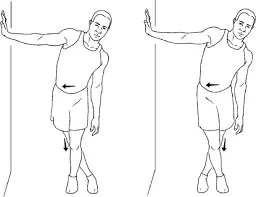
Which safety measures are necessary when exercising?
- Maintaining good posture is important when exercising.
- Try to avoid jerky hip movements when doing exercise.
- Do some light stretches.
- Avoid painful exercise.
- It’s okay if it hurts while you stretch the tight muscle. But you shouldn’t feel any intense or stabbing pain during the stretch.
- Avoid wearing tight clothing and dress comfortably so that your body may move freely when working out.
- It is important to do all exercises following the protocol, which calls for stretches before and holds in between each exercise as well as the right amount of repetitions for each exercise.
When should you stop exercising?
- You’re suffering from illness.
- High temperature
- Swelling
- Exercise should be stopped if it hurts.
- blurred vision
Advice for relieving hip osteoarthritis:
- Pay attention to your body and modify your activity properly.
- Keep with low-impact workouts that help build stronger hip musculature.
- Control your weight: being obese might put a strain on your hips.
- Stop and take a break if the pain gets worse.
- For hip pain, take over-the-counter anti-inflammatory drugs.
- You are overstressing your hip if joint pain continues hours after you’ve stopped exercising.
- Walking whenever you can will help you be more active during the day.
- Be sure you’re getting a good night’s rest.
- If you believe using a cane might be necessary, speak with your doctor.
Activity You Should Skip:
Before attempting this or any other high-impact workout, consult your physician or physical therapist. You’ll learn what’s safe from them. Your doctor would probably advise against the following kinds of exercise if you have severe osteoarthritis;
- Jogging
- Basketball
- Football
- Tennis
- Everything involving a lot of jumps
Summary
Hip Osteoarthritis, which can be referred to as inflammation of the hip joint, is also known as wear and tear on the hip joint. Aging, excessive use, being overweight, genetic problems, or underlying genetic factors can all contribute to this. The smooth cartilage at the end of the bones that facilitates easy movement of the hip joints may eventually degenerate.
Living with arthritis requires changing your lifestyle, taking medicine as needed, and being mindful of participating in physiotherapy and other forms of rehabilitation in addition to other therapies.
Pain reduction, greater range of motion, and stronger muscles can all be achieved with mild hip stretches and exercises. To achieve this goal, you can choose from a variety of hip exercises. To better manage their hip osteoarthritis, people with the condition should try out various activities with the help of their therapist. Once they find the exercises that suit them, they can add them to their regular exercise schedule.
You should pay attention to your level of pain when exercising, especially during the beginning. There’s a chance that these exercises initially exacerbate your problems. But with continued practice, they should become less difficult over time and act for improved hip mobility.
FAQ:
Which form of exercise is best for hip osteoarthritis?
Bridging
Double hip rotation
Hip extension
Prone leg straight raise exercise
Heel Slide
Clam Hip Abduction
Does hip osteoarthritis benefit from walking as an exercise?
One of the best exercises we can and should do for hip arthritis is walking. If you’re just starting with walking, aim to go for a couple of walks of ten minutes each day. Gradually increase your walking distance and speed from a gentle start.
Does stair climbing help people with hip osteoarthritis?
Climbing stairs can worsen the symptoms of hip pain for most people. Workers whose jobs need them to climb stairs might look for therapy for this pain sooner than other employees.
Will osteoarthritis in the hips heal?
While there’s no known cure for osteoarthritis, there are things you may do to reduce its effects on yourself. Additionally, several therapies may help you move more freely and experience much less pain.
With hip osteoarthritis, what should a person not do?
Stay away from high-impact workouts like sprinting and jumping as these could worsen hip arthritis. Losing weight is one way to modify people’s lifestyles and reduce the strain on the hip joint. Exercises used in physical therapy can help strengthen the hips.
What are the four phases of hip osteoarthritis?
The first phase is Minor. Small signs of stress will first appear, which makes it simple to pass this stage without even realizing it.
The second phase is moderate. Eventually, the slowly developing bone spurs will become visible on X-rays.
The third phase is moderate.
The fourth phase is severe.
How did I naturally treat my osteoarthritis in my hips?
For those with osteoarthritis, exercising and keeping a healthy weight are two practical strategies that reduce pain and increase mobility. Additional treatments that may alleviate symptoms include joint supports, hot and cold compresses, and pain-relieving ointments.
Which foods should people with osteoarthritis stay away from?
Maintaining a healthy diet and way of life can help reduce the symptoms of arthritis. limiting a person’s consumption of fried meals, highly processed foods, alcohol, and added sugars, among other foods and drinks.
If you have hip pain, is it better to rest or exercise?
If you experience hip and knee pain, it could be time to change up your exercise routine. Exercise is not only a healthy habit; it also works well for numerous knee and hip issues. Additionally, workouts that build the muscles that support the hips and knees can be quite beneficial.
Which physical activities aggravate osteoarthritis?
Stair climbing.
Jumping.
Hiking.
Prolonged standing.
What kinds of activities are common for osteoarthritis exercises?
Using a personal trainer, swimming, walking, cycling, and rowing are all excellent options. Sports that require rapid stops, quick turns, or jumping, like basketball and tennis, may be harmful to your joints. You should stay away from activities like sprinting.
Is osteoarthritis reversible with exercise?
In fact, for people with osteoarthritis, exercise is believed to be the most successful non-pharmacological treatment for reducing pain and improving mobility.
What age group does hip osteoarthritis typically affect?
While it can affect those younger as well, people 50 years of age and older are most commonly affected by osteoarthritis, a degenerative form of arthritis. a hip that has osteoarthritis damage. The cartilage in the hip joint begins to wear down over time in osteoarthritis.
When I have hip arthritis, how should I sleep?
Turn around on your back to sleep.
Try placing a pillow below your knees or slightly behind your back to alleviate pressure and maintain your hip alignment if switching positions during the night is difficult for you. A more supportive mattress or a mattress topper may also be helpful.
What is hip osteoarthritis in its late stages?
The progressive degeneration of the cartilage between a joint’s bones, which results in the bones rubbing painfully against one another when the joint is moved, is known as end-stage arthritis. Severe pain and loss of function come from this.
Can osteoarthritis be alleviated by physiotherapy?
Reducing pain, improving joint function, and restoring the patient’s health are the main objectives of physical therapy for Osteoarthritis. This helps the patient to get back a sufficient range of motion for everyday activities.
Is stretching beneficial for osteoarthritis hips?
Hip arthritis pain may worsen if you have tight glutes and lower back muscles. Reducing your pain and tension in these muscles can be achieved with the knees-to-chest stretch.
Does exercise help with hip pain relief?
Exercises for strengthening and stretching are only two of the various methods available to you for treating hip pain, but they might not be enough. You can treat your hip pain conservatively by increasing your level of activity, eating well, decreasing weight, using over-the-counter medications, and utilizing cold/hot treatment.
How could hip pain be relieved by exercise?
Hip stretches and exercises can help strengthen muscles, improve range of motion, and reduce pain. There are a lot of exercises available, but individuals can try different ones until they find the ones that suit them the most, and then include those exercises into a routine.
Is osteoarthritis effectively treated by exercise?
It improves general health in addition to helping with pain and stiffness relief. It also helps prevent various illnesses that are common in older adults and improves your mood. Exercise is essential for both preventing and treating osteoarthritis, particularly in those 65 years of age and older.
Does osteoarthritis get better?
Although osteoarthritis is a chronic illness that cannot be treated, it sometimes improves gradually and does not always get worse with time. There are also some therapies available that reduce the symptoms.
Does resting help with osteoarthritis?
The knees, hips, spine, and hands are the joints most frequently affected. Osteoarthritis pain gets worse with overuse and gets better with rest.
Does yoga help people with osteoarthritis?
The benefits of mild exercise in reducing pain and stiffness associated with arthritis. However, exercise doesn’t have to be difficult. Tai chi and yoga are useful for people with arthritis, as they improve mental well-being and increase strength, flexibility, and fitness.
How can osteoarthritis be reduced?
One of the most important ways to reduce the stiffness and pain in your joints caused by osteoarthritis is to exercise and lose weight if you are overweight. Work out. Exercises with little impact on your body can improve your strength and develop the muscles surrounding your joints, resulting in increased stability.
Should I still work out if I have hip pain?
During the hip arthritis healing phase, a small amount of pain is tolerable. However, it’s important to avoid doing exercises that could result in severe hip pain. The hip joints and muscles may suffer as a result.
Can too much exercise cause hip pain?
Hip pain often has a straightforward cause, such as excessive exercise during exercise. In this case, the pain usually comes from strained or inflamed soft tissues, such as tendons, which normally go away in a few days. A few conditions may be the cause of chronic hip pain.
Is it possible for hip pain to start suddenly?
The pain is localized to the hip joint and may come on gradually or suddenly. Additionally, you can experience hip stiffness and a decrease in hip range of motion. Steroid injections, over-the-counter pain and anti-inflammatory drugs, ice packs, and rest are among the forms of treatment.
Is regular exercise beneficial for arthritis?
Exercise is a must for everyone, but it’s especially important for those who have arthritis in particular. Exercise improves strength and improves movement. Both pain in the joints and stiffness can be reduced with exercise.
What is beneficial for osteoarthritis?
One of the most significant strategies to reduce osteoarthritis-related joint pain and stiffness is to exercise and, if you are overweight, lose weight. Get moving. Your joint will become more stable as a result of low-impact exercise’s ability to build surrounding muscle strength and improve endurance. Consider doing water aerobics, cycling, or walking.
Osteoarthritis: is it temporary?
A condition that progresses over time is osteoarthritis. An episode or time-lapse can cause symptoms to get worse. In most cases, the episode is short. When they arise, lifestyle changes and medication can frequently help control them.
How is osteoarthritis diagnosed?
Having X-rays taken of your joint can provide images of bone deterioration, remodeling of the bone, bone spurs, and loss of joint space. X-rays typically do not show early joint deterioration.
Damage to the soft tissues within and surrounding the joint can be seen with magnetic resonance imaging (MRI).
How may osteoarthritis be prevented?
It’s possible that osteoarthritis will not entirely go away. However, maintaining a healthy lifestyle may improve both your general well-being and joint health. It’s important to exercise, keep blood sugar under control, maintain a healthy weight, and protect against joint damage. This may reduce the possibility that osteoarthritis will appear.
References:
- Pietrangelo, A. Sept. 18, 2018. Healthline.com/health/osteoarthritis/hip-exercises-treatment#strength-training. Osteoarthritis Hip Exercises Citation inside the text: Pietrangelo (2018)
- 5 exercises to relieve hip pain from osteoarthritis Medibank, n.d. Best exercises for arthritic hip pain: Medibank. https://www.medibank.com.au/health-support/joint-health/article/
Inside-Text Citation: (5 Osteoarthritis Hip Pain Exercises | Medibank, n.d.) - J. S. Melvin (n.d.). 7 Core Exercises to Reduce Pain from Hip and Back Arthritis. Health and arthritis. The following seven core exercises can help relieve back and hip arthritis pain: https://www.arthritis-health.com/blog
Reference within the text: Melvin, n.d. - Wiginton, K. August 28, 2020. Osteoarthritis Exercises for the Knee and Hips. Knee and hip exercises for osteoarthritis from WebMD. https://www.webmd.com/osteoarthritis
Reference within the text: Wignton, 2020 - Image 1, Browse 68,999 Stock Photos, Vectors, and Videos at Bridging Exercise Images. (As of now). Adobe Images. bridging+exercise in https://stock.adobe.com/in/search?k=
Reference inside text: (Bridging Exercise Images – Search 68,999 Images, Vectors, and Videos, n.d.) - Image 2, Exercise: chair sit to stand. (n.d.). @recalfreno.com; https://www.biagfo.top/products.aspx?cname=chair+sit+to+stand+exercise&cid=25
The Chair Sit to Stand Exercise is cited in-text. - Image 4, Cpt, A. A. (January 26, 2024). Hamstring stretches for tight muscles. Verywell Medical. Excellent hamstring stretches: https://www.verywellhealth.com/296849
Citation within text: (Cpt, 2024) - Image 5, The new mobility defense is stretching. (November 8, 2016). Harvard Medical. Stretching the New Mobility Protection: https://www.health.harvard.edu/staying-healthy
Reference within the text: (Stretching: The New Mobility Protection, 2016) - Image 6, Weg, A., and M. Rabbitt (2023, December 13) generated Image 6. The Top 13 Lower Back Stretches Recommended by Experts. It offers five stretches that can help with lower back pain relief. For further details, go to their website. Within-text citation: Weg & Rabbit, 2023
- Image 8, Putra, L. (January 3, 2023). Download the exercise of a woman performing leg lifts while lying prone. Isolated flat vector image against a white backdrop. Vecteezy.com/vector-art/16137869-woman-doing-prone-or-lying-down-leg-lifts-flat-exercise-illustration-separated-on-white-background
Citation within text: (Putra, 2023) - Image 9, Hip-flexor exercises. (n.d). In contrast to arthritis. Exercises for healthy joints and strong hips can be found at https://versusarthritis.org/about-arthritis/exercising-with-arthritis/
Reference inside text: (Hips Exercises, n.d.) - Image 11, The Single Knee-to-Chest Exercise: How to Perform It | NYP (n.d.). The Presbyterian New York. The single-knee-to-chest exercise can be performed as follows: https://www.nyp.org/healthlibrary/multimedia
In-text Citation: (NYP, n.d.) “How to Perform the Single Knee-to-Chest Exercise” - Image 12, U. on February 5, 2023. Stretch Your Inner Thighs and Hips Gently with the Reclined Bound Angle Pose. @yogawithuliana.com/poses/reclined-bound-angle-pose/Reference in Text: (2023)
- Image 13, September 12, 2023: Maguire, J. Clamshell Exercise: Why You Should Do This Glute-Strengthening Move. BODi. Clamshell Exercise: https://www.beachbodyondemand.com/blog
Citation within the text: (Maguire, 2023) - Image 16, Mazzo, L. June 12, 2022. The Best 6 Hamstring Stretches to Increase Flexibility and Release Tight Muscles. Form. Best hamstring stretches can be found at https://www.shape.com/fitness/workouts/leg-workouts
Citation within text: Mazzolo, 2022 - Image 18, Online Store 9904447 (n.d.). 9904447.html at https://mallgoodsm.life/product_details. Reference within the text: (9904447 – Online Store, n.d.)
- Image 24, (n.d.) livebetterphysiotherapy.com.au. www.livebetterphysiotherapy.com.au/?m=hip-pain-exercises-ready LivebetterPhysiotherapy.com.au (n.d.) is the in-text citation.
- Image 25, Bsn, K. A. K. (May 4, 2020). Wednesday Workouts – Part 1 of Standing Leg Exercises. Cancer Blogs on CovidLink. Wednesdays are for working out! Here are some standing leg exercises in part 1.
Reference inside text: (Bsn, 2020) - Image 26, Worthington, D. (March 12, 2018). Squat your way from zero to hero! Personal Training Devizes at Studio-10 Fitness & Wellness. Personal Training Devizes at Studio-10 Fitness & Wellness. Zero to hero with the squat: https://dylanworthington.com/blog-dylan-worthington-personal-trainer-devizes/2017/6/22/
Reference within the text: Worthington, 2018 - Image 27, Short Arcs, Quadriceps (Strength). (n.d.). Saint Luke’s Medical Center. The strength of the quadriceps is attributed to their short arcs.
In-text Citation: (Strength, Short Arcs, Quadriceps, n.d.) - Image 28, Dr. Naveen Reddy’s hip (n.d.). Medicus Naveen Reddy. Hip physiotherapy at https://www.drnaveenreddyortho.com/
Reference within the text: Hip – Dr. Naveen Reddy, n.d. - Image 29, L. (February 7, 2014). Exercise for Hip Adduction (Side Lying). Use Golf Loopy to Play Like a Champion. This exercise involves hip adduction while lying down on the side.
The 2014 In-Text Citation - Image 30, Prone hip extension (Figure 1), n.d. http://www.researchgate.net/figure/Prone-hip-extension_fig1_322501817, ResearchGate.
Reference inside text: (Figure 1. Posterior Hip Extension., n.d.)

